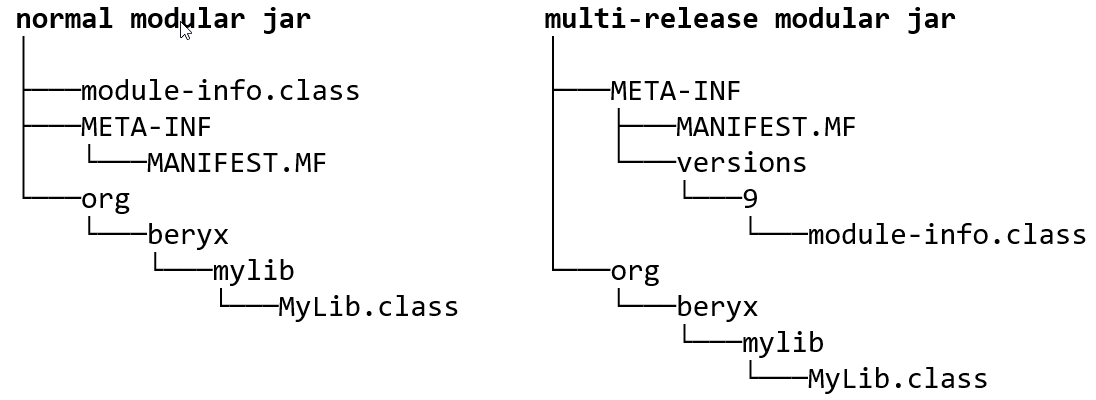If you’re a library author, you probably want to see your library used in a large number of applications. One way to increase the number of applications that can include your library is to make it compatible with older Java versions. At the same time, you may consider modularizing your library in order to make it attractive for applications that take full advantage of the Java Platform Module System (JPMS).
However, the JPMS is implemented only by Java 9 and newer versions. So, how can you build a library that is both modularized and compatible with Java versions before 9?
A modular jar is just a normal jar that includes a module-info.class file, which represents the module descriptor.
This module descriptor is typically produced by compiling a corresponding module-info.java file.
The module descriptor is ignored when running on Java 8 and older versions, because module-info is not a legal Java identifier.
This means that a modular jar compatible with a pre-Java 9 release can be produced by creating a normal jar
for the target version and inserting a module descriptor into it.
The standard way to do this implies invoking the java compiler twice:
- compile all sources except
module-info.javausing the appropriatejavacflags to provide compatibility with the target pre-Java 9 version. - compile
module-info.javausing a Java 9+ compiler.
Maven
Maven describes a build method along the lines of the above mentioned strategy..
An alternative solution is offered by ModiTect, a Maven plugin for working with the Java 9 module system.
One of the goals provided by ModiTect is add-module-info, which allows you to add a module descriptor to the JAR produced by the current Maven project:
...
<plugin>
<groupId>org.moditect</groupId>
<artifactId>moditect-maven-plugin</artifactId>
<version>1.0.0.Beta1</version>
<executions>
<execution>
<id>add-module-infos</id>
<phase>package</phase>
<goals>
<goal>add-module-info</goal>
</goals>
<configuration>
<jvmVersion>11</jvmVersion>
<module>
<moduleInfoFile>
${basedir}/src/main/java/module-info.java
</moduleInfoFile>
</module>
</configuration>
</execution>
</executions>
</plugin>
...ModiTect uses a clever technique to create the module descriptor without the need of a Java compiler.
It analyzes the module-info.java file with the JavaParser and uses the
ASM bytecode manipulation framework to generate the corresponding module descriptor.
This way, it allows you to create a modular jar even if you use a pre-Java 9 compiler.
Gradle
Taking inspiration from ModiTect’s approach, I implemented a Gradle plugin for creating modular jars that target Java 8 or older versions.
Using this plugin is straightforward: in build.gradle you just need to add the plugin
and specify the Java version targeted by your library:
plugins {
id 'java'
id 'org.beryx.jar' version '1.0.0'
}
sourceCompatibility = 1.8
targetCompatibility = 1.8After placing the module-info.java file in the src/main/java directory of your project, you can build the modular jar with:
./gradlew jarYou don’t need a Java 9+ compiler to build the modular jar, because the plugin uses the same technique as ModiTect. However, keep in mind that this technique cannot check the validity of your module descriptor. References to nonexistent packages, modules, services, or service implementations go undetected.
Therefore, it is strongly advised to validate your module descriptor by additionally building your project using a Java 9+ compiler with the sourceCompatibility and targetCompatibility set accordingly.
The good news is that you don’t need to change your build script in order to do this.
The plugin lets you override the sourceCompatibility and targetCompatibility values by setting the project property javaCompatibility:
./gradlew -PjavaCompatibility=9 jarNote that this project property overrides both sourceCompatibility and targetCompatibility with the same value.
If the plugin detects that at least one of sourceCompatibility and targetCompatibility has an effective value >= 9, it automatically applies the Chainsaw plugin, which adds support for the JPMS.
That’s why no changes are required to your build script when running in Java 9+ compatibility mode.
In the discussion above we considered that sourceCompatibility and targetCompatibility are configured with pre-Java 9 values in build.gradle and you override them with 9+ values using the javaCompatibility project property.
You can also work the other way around: set sourceCompatibility and targetCompatibility with 9+ values in build.gradle and override them with a pre-Java 9 value (via javaCompatibility) in order to generate a modular jar targeted to Java releases before 9.
Both approaches have their pros and cons.
Choose the one that suits you the most.
The important thing is to test your library constantly on both the class-path and the module-path.
The best way to do this is to configure your continuous integration server to execute the Gradle build twice:
once with the javaCompatibility property set and once without it.
Typically, a modular jar includes the module-info.class file in its root directory.
This may cause problems for some older tools, which incorrectly process the module descriptor as if it were a normal Java class.
To provide the best backward compatibility, the plugin creates by default a modular multi-release jar
with the module-info.class file located in META-INF/versions/9, as shown below.

If, for some reason, you don’t want to create a multi-release jar, set the multiRelease property to false
in the jar section of your build script:
jar {
...
multiRelease = false
...
}Examples
To illustrate how to use this plugin, I implemented a Java library and a Kotlin library for solving the N-Queens problem.
Note how Travis is configured in these projects to test the library on both the module-path and the class-path:
./gradlew -PjavaCompatibility=11 --no-daemon -i -s build
./gradlew --no-daemon -i -s build